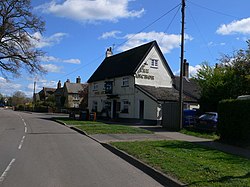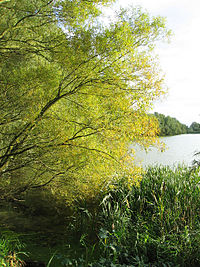Little Paxton
| Little Paxton | |
| Huntingdonshire | |
|---|---|
 High Street | |
| Location | |
| Grid reference: | TL195628 |
| Location: | 52°15’0"N, 0°15’0"W |
| Data | |
| Postcode: | PE19 |
| Dialling code: | 01480 |
| Local Government | |
| Council: | Huntingdonshire |
| Parliamentary constituency: |
Huntingdon |
Little Paxton in is a village in Huntingdonshire, lying a mile to the north of St Neots. Its neighbour village is Great Paxton.
Until the 1970s, Little Paxton it was a minor village and the church sapped of congregation was under threat of closure. However the influence of St Neots made itself felt, a housing estate and a junior school were built and the village was soon abuzz. The Paxton Pits Nature Reserve was established around part of the nearby gravel pits and this has brought visitors to the village.
Today, Little Paxton is larger than Great Paxton.
About the village
The River Great Ouse forms the boundary to the south-east and standing on it is a paper mill and lock gates. The river forms part of the Paxton Pits Nature Reserve which has been designated a "Site of Special Scientific Interest" giving the area statutory protection.
The village has one public house, The Anchor. Gravel extraction remains an important industry in and around the village. On the edge of the village, a derelict industrial site has been redeveloped to provide riverside housing, extending the village towards the outskirts of St. Neots.
The old village centres on St. James Church and the large playing field has an excellent children's play area.
Paxton Pits

The Paxton Pits Nature Reserve has a large variety of meadow plants and is of considerable nature conservation value, especially for certain species of wildfowl; in particular Paxton Pits accommodates one of the largest inland cormorant colonies in the United Kingdom.
Within the reserve is a footpath network, including nature trails and observation points for bird watchers, and a Visitors Centre.
The lakes areas have been formed from disused gravel pits. All together the nature reserve features lakes, woodland and part of the Great Ouse floodplain. Cormorants, grebes, ducks and geese have colonised the lakes.
Industry
Apart from the gravel pits are closed, Little Paxton is busy with industry. It has its own industrial area and developing science park accommodating the latest technology, providing jobs and investment opportunities over and above those offered by the major towns and cities situated within a 20 mile radius. With the A1 trunk road to the north-west and a main line station at St Neots there is easy access to all areas
Outside links
| ("Wikimedia Commons" has material about Little Paxton) |
